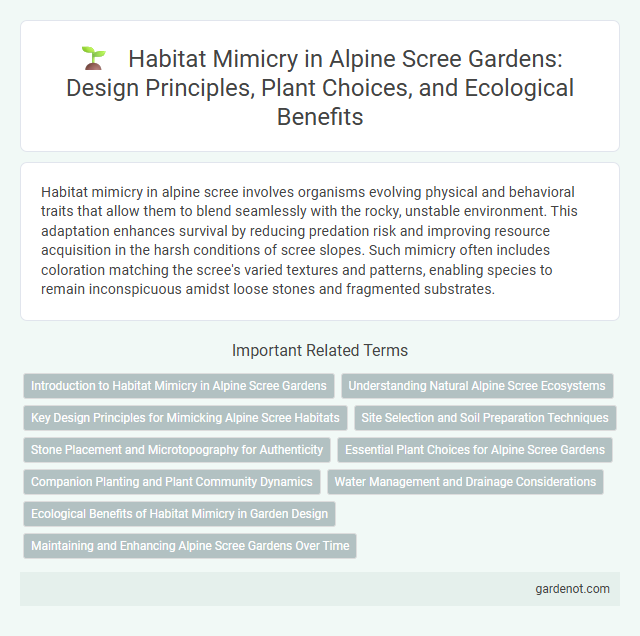Habitat mimicry in alpine scree involves organisms evolving physical and behavioral traits that allow them to blend seamlessly with the rocky, unstable environment. This adaptation enhances survival by reducing predation risk and improving resource acquisition in the harsh conditions of scree slopes. Such mimicry often includes coloration matching the scree's varied textures and patterns, enabling species to remain inconspicuous amidst loose stones and fragmented substrates.
Introduction to Habitat Mimicry in Alpine Scree Gardens
Habitat mimicry in alpine scree gardens replicates the natural rocky, well-drained environments essential for specialized plant species. These gardens recreate microhabitats with loose stones, sharp drainage, and temperature fluctuations to support alpine flora adaptation and survival. Effective habitat mimicry enhances biodiversity while promoting ecological balance in controlled settings.
Understanding Natural Alpine Scree Ecosystems
Natural alpine scree ecosystems exhibit habitat mimicry through specialized plant and animal species adapted to rocky, unstable substrates, enabling survival in extreme conditions. Vegetation such as Saxifraga and specialized invertebrates mimic surrounding rock textures and colors, enhancing camouflage and predator avoidance. Understanding these adaptive strategies provides insight into ecological resilience and biodiversity maintenance in high-altitude environments.
Key Design Principles for Mimicking Alpine Scree Habitats
Key design principles for mimicking alpine scree habitats emphasize replicating the structural heterogeneity and drainage patterns characteristic of loose, rocky debris found on steep mountain slopes. Incorporating a mix of angular stones and varied substrate sizes promotes microhabitats essential for endemic flora and fauna adapted to high-altitude, unstable conditions. Ensuring appropriate exposure to sunlight, wind, and temperature fluctuations further supports the unique ecological dynamics typical of alpine scree environments.
Site Selection and Soil Preparation Techniques
Alpine scree habitats require careful site selection that prioritizes rocky, well-drained slopes with minimal organic debris to mimic natural conditions. Soil preparation techniques involve creating a loose, coarse substrate by incorporating gravel and coarse sand to replicate the scree's unstable structure. Ensuring adequate drainage and preventing soil compaction are critical for promoting native alpine flora establishment and survival.
Stone Placement and Microtopography for Authenticity
Optimal stone placement in alpine scree habitats enhances authenticity by replicating natural microtopography, fostering similar moisture retention and thermal conditions essential for native flora and fauna. Microtopographic variation created through strategic boulder and pebble arrangement promotes biodiversity by providing microhabitats that mimic natural scree slopes. This habitat mimicry supports specialized species, ensuring ecological resilience and functional integrity within engineered or restored alpine environments.
Essential Plant Choices for Alpine Scree Gardens
Essential plant choices for alpine scree gardens include hardy, drought-tolerant species such as Saxifraga, Silene, and Androsace that naturally thrive in rocky, nutrient-poor soils. These plants mimic the habitat's harsh conditions by requiring excellent drainage, full sun exposure, and minimal water, ensuring they adapt well to scree garden environments. Incorporating native alpine species like cushion plants enhances habitat mimicry, supporting local biodiversity and creating a resilient, low-maintenance garden ecosystem.
Companion Planting and Plant Community Dynamics
Alpine scree habitats exhibit complex plant community dynamics where companion planting enhances survival and growth by mimicking natural habitat conditions. Species like Saxifraga and Draba often co-occur, creating microhabitats that stabilize soil and retain moisture, fostering mutualistic interactions. This habitat mimicry through strategic planting supports biodiversity and resilience against harsh alpine environmental stresses.
Water Management and Drainage Considerations
Alpine scree habitats rely on intricate water management and drainage systems to sustain specialized vegetation and fauna adapted to fast-draining, nutrient-poor substrates. Effective water drainage prevents waterlogging and erosion, promoting soil stability and microhabitats essential for endemic species. Understanding these hydrological dynamics aids in preserving biodiversity and mitigating the impact of climate change on alpine ecosystems.
Ecological Benefits of Habitat Mimicry in Garden Design
Habitat mimicry in garden design replicates alpine scree environments, promoting biodiversity by providing specialized niches for native flora and fauna adapted to rocky, well-drained soils. This approach enhances ecological resilience by supporting pollinators, soil microbes, and drought-tolerant plants, reducing the need for irrigation and chemical inputs. Incorporating alpine scree habitat features improves water conservation and soil stability, fostering sustainable green spaces that mirror natural alpine ecosystems.
Maintaining and Enhancing Alpine Scree Gardens Over Time
Maintaining and enhancing alpine scree gardens requires replicating the natural habitat's drainage, soil composition, and microclimate to support native scree vegetation and specialized alpine flora. Regular monitoring of soil erosion and adjusting rock placement helps preserve the delicate balance of moisture and airflow essential for plant health. Introducing native species and minimizing invasive plants promote biodiversity, ensuring sustainable growth and resilience within alpine scree ecosystems.
Habitat mimicry Infographic

 gardenot.com
gardenot.com